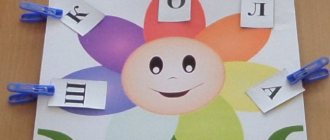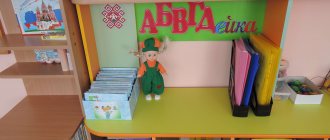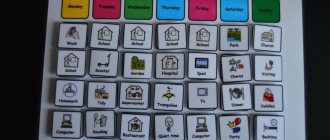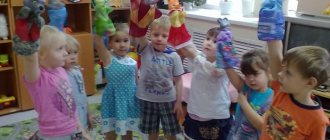www.Logopedy.ru
Author: Zakharova Yulia Alexandrovna
teacher-speech therapist MADOU "Kindergarten "141"
Aircraft construction district of Kazan.
Original: .
The formation of speech breathing involves, among other things, the production of an air stream. The production of an air stream is considered one of the necessary and significant conditions for producing sounds. Work on the education of an air stream begins at the preparatory stage of the formation of correct sound pronunciation, along with the development of phonemic hearing and articulatory motor skills
Parameters of correct oral exhalation:
- exhalation is preceded by a strong inhalation through the nose - “we take a full chest of air”; - exhalation occurs smoothly, slowly, evenly, and not in jerks; — during exhalation, the lips form a tube; you should not compress your lips;
- do not puff out your cheeks!!!; — during exhalation, air exits through the mouth; air should not be allowed to exit through the nose. - you should exhale until the air runs out;
Ask the child to blow through the lips extended in a tube - Without puffing out the cheeks, blow through the lips brought together and slightly pushed forward, forming a round “window” in the middle.
• Blow away any soft object (cotton ball, paper snowflake, etc.) from the palm of your hand brought to your mouth. Blow on pieces of cotton wool tied on a thread.
• Blow on a pencil lying on the table so that it rolls.
• Blowing soap bubbles.
• Blowing using whistles, horns, pipes, harmonica.
• Races on water with paper boats and celluloid toys, for example, blowing up “fish”. Children are asked to take turns blowing on light toys placed in a basin of water.
• Blow into the water through a straw to make the water in the glass “boil.”
When playing games aimed at developing a child's breathing, it is necessary to keep in mind that breathing exercises quickly tire the child and can even cause dizziness. Therefore, such games must be limited in time (you can use an hourglass) and be sure to alternate with other exercises.
The formation of speech breathing involves, among other things, the production of an air stream. The production of an air stream is considered one of the necessary and significant conditions for producing sounds. Work on the education of an air stream begins at the preparatory stage of the formation of correct sound pronunciation, along with the development of phonemic hearing and articulatory motor skills
Parameters of correct oral exhalation:
- exhalation is preceded by a strong inhalation through the nose - “we take a full chest of air”; - exhalation occurs smoothly, slowly, evenly, and not in jerks; — during exhalation, the lips form a tube; you should not compress your lips;
- do not puff out your cheeks!!!; — during exhalation, air exits through the mouth; air should not be allowed to exit through the nose. - you should exhale until the air runs out;
Ask the child to blow through the lips extended in a tube - Without puffing out the cheeks, blow through the lips brought together and slightly pushed forward, forming a round “window” in the middle.
• Blow away any soft object (cotton ball, paper snowflake, etc.) from the palm of your hand brought to your mouth. Blow on pieces of cotton wool tied on a thread.
• Blow on a pencil lying on the table so that it rolls.
• Blowing soap bubbles.
• Blowing using whistles, horns, pipes, harmonica.
• Races on water with paper boats and celluloid toys, for example, blowing up “fish”. Children are asked to take turns blowing on light toys placed in a basin of water.
• Blow into the water through a straw to make the water in the glass “boil.”
When playing games aimed at developing a child's breathing, it is necessary to keep in mind that breathing exercises quickly tire the child and can even cause dizziness. Therefore, such games must be limited in time (you can use an hourglass) and be sure to alternate with other exercises.
Social commentary Cackle
Air jet development benefits
Exhale through the mouth: light, smooth, long. • Monitor the direction of the air stream.
• Exercises do not last longer than 3 minutes. • The amount and pace of exercises should be dosed correctly: blow intensely no more than 5 times. • Make sure that your cheeks do not puff out during exercise.
• Exhaled air must not be retained. • Exercises are easier to do by counting.
• For visual control at the initial stages, the use of a mirror is allowed. • The exhaled air stream is controlled using a cotton swab brought to the child’s mouth: if done correctly, the cotton swab will deflect.
I offer teaching aids that I have developed that will help produce a strong and smooth air stream. 1. "Cup of tea"
We ask you to blow on your child for a cup of hot tea
Consultation on the topic “Formation of an air stream”.
In any type of breathing, the diaphragm is active to a greater or lesser extent.
Therefore, practically we can only talk about predominantly key, predominantly abdominal, or clavicular breathing. Types of breathing depend on gender, age, profession.
Thus, in women the thoracic type of breathing is more often observed, in men - the abdominal type, in manual workers the abdominal type of breathing prevails, in persons engaged in clerical and generally sedentary work - the thoracic type. Children usually have a mixed type of breathing, that is, an average between abdominal and thoracic.
We recommend reading: Return to delivery point
With deep or full breathing, three types of breathing are combined - clavicular, thoracic, abdominal.
Within 1 minute, 16-20 complete respiratory movements (inhalations and exhalations) occur.
The duration of inhalation is almost equal to the duration of exhalation (the ratio of inhalation to exhalation time is approximately 1: 1.25).
This is physiological breathing necessary for life. But in order for a child to start speaking, he must master a special type of breathing - speech breathing.
Formation of an air stream in children with sound pronunciation disorders
This is typical for the pronunciation of stop-passive (l, l') sounds. The following exercises are used in speech therapy work: 1. “Blow the snowflakes off the slide.” "Punish the naughty tongue." "Groove".
2. "Tricks". 3. “A hunter is walking through the swamp.”
The production of an air stream can be carried out before articulatory gymnastics or simultaneously with articulatory gymnastics, since the cheeks, lips, and tongue take an active part in the formation of the air stream.
Articulation exercises performed while exhaling “Turkey Poults”. As you exhale, pronounce “Bl-bl-bl.” "Punish the naughty tongue." As you exhale, pronounce “P-p-p.”
| "Machine gun". As you exhale, pronounce “T-t-t.”
"Motor". As you exhale, pronounce “R-r-r.” "Bug". As you exhale, pronounce “Zh-zh-zh.” The main directions of the air stream - Blowing with closed lips.
-Blowing through the lips, elongated with a tube.
-Pouting through lips stretched in a smile. -Blow on the tongue. Exercises to develop air flow
Breathing exercises and games
Blow out the candle.
In the garden I use a safe option with an electronic candle, which lights up and goes out when you blow on it. https://www.youtube.com/watch?v=NEKxPipoK3U (video with an electronic candle)2. Blow on a dandelion.3. Inflate the balloon.4.
Blow through a straw into the soap solution5.
Blow the ball out of the cup.6. You can smear the ball with paint and draw with it, blowing from a straw7. Blow the paper off the tube8. Games with whistles, which are sold in birthday sets: Games to develop the duration of the air stream1. Blow on the turntable. The longer you blow, the longer it spins. how to do it: https://astersoft.net/kak-sdelat-vertushku-poshagovaja-instruktsija2.
Blow soap bubbles. The longer you blow, the more bubbles there are.
The force here must be controlled, since if you blow hard, the bubbles will burst and will not fly away.3. Blow a bubble from chewing gum4. Blow on this design: 5. Wind musical instruments:
Didactic aids and games for the development of speech breathing
Correct speech breathing is the key to success in mastering the correct pronunciation of sounds. Goal: formation of speech breathing through didactic games and exercises.
The set of game aids consists of game exercises for the development of an air stream, the goals and objectives of which are: - formation of a targeted air stream.
-development of air jet force. -development of breathing through the production of an air stream and mastery of the articulation of certain sounds.
- activation of the labial muscles. In the process of corrective work on the formation of an air stream, it is important to adhere to the following methodological recommendations: - exercises are carried out in a well-ventilated room; - pay attention to the fact that the child inhales deeply and calmly through the nose.
- exhalation through the mouth should be light, smooth, long, economical, without tension; -monitor the accuracy of air direction
Do-it-yourself didactic aids for the development of speech breathing
I made wings out of corrugated paper, twisted the torso and head out of a candy wrapper, and attached them to the wings.
I took a bottle of medicine (they were drops for a runny nose)
She removed the cork and took out the ring.
I attached the thread, the butterflies are ready.
It is very convenient for the size of children's fingers.
So, for example, when studying the topic “Vegetables,” you can invite children to first look at the planted vegetables in the garden, name them, and then blow on the feathers of onions and the tops of carrots and turnips.
Master class on making a manual for the development of air flow “Skier”
A soft, flat tongue is a prerequisite.
Here are several games that can be used to develop the air stream: “Parachute” or “Focus” - open your mouth slightly, push your tongue forward and lift it with a “cup”, exhale smoothly onto the cotton wool lying on the tip of the nose, or onto the forehead. “Storm in a glass” - pour 150 ml of water into a glass and insert a cocktail straw.
First, the child slowly exhales air through the tube - the kettle begins to boil, gradually increase the exhalation - the kettle boils, exhale even more forcefully - now the water should boil.
We make sure that the hangers do not rise.
“Score a goal” - is performed with the tongue stuck out and folded into a tube, a piece of cotton wool rolled into a ball on the tip of the tongue, the air should pass through the middle of the tongue. In this case, a strong air stream is formed, which will blow away the fleece or score a goal. Breathing is even, the shoulders do not rise: inhale through the nose, exhale through the mouth.
“Blow, breeze” - when blowing: inhale with the diaphragm (inflate the tummy, do not hold your breath; while exhaling, use the lips as a tube, the tongue as a groove (so that the air stream goes in the middle of the tongue, do not inflate the cheeks, exhale smoothly.
Ready-made games and toys, such as air basketball, pipes, turntables, various whistles and reeds, inflating balloons and soap bubbles. Games that you can make with your own hands.
“Bean Race” - a candy box is equipped as a track for runners - “beans”, and they start running with the help of the “wind” from cocktail tubes. The one who gets his runner to the finish line the fastest will win.
“Boat” - you will need a basin of water and paper boats. You need to simulate a weak wind so that the boat moves smoothly, and a gusty wind. You can blow by stretching out your lips with a tube, but without puffing out your cheeks, or by folding your tongue into a groove.
"Air Football" - This fun and useful game is intended for two children. The essence of the game is to score a goal against the opponent. You can play with a straw, or without it.
“Feed the Animals” is intended for one, two or even three children at a time. The essence of the game is for children to blow on the ball and get it into the animal's mouth. The role of the ball can be played by a candy wrapper, a piece of cotton wool or a crumpled paper napkin. It turns into delicious food. “Fish - whale” - blow into the tube and the whale will release a cheerful fountain.
“Air racing” – the winner is the one whose race reaches the finish line faster.
In the process of corrective work on the formation of an air stream, it is important to adhere to the following methodological recommendations.
• Exercises are carried out in a well-ventilated area. • It is better to perform the exercises while standing, with the body in a free position in space.
We recommend reading: Limit amount for UTII
The chest is straightened. Watch your posture.
• Attention is drawn to ensuring that the child inhales deeply and calmly through the nose.
Exhalation through the mouth should be light, smooth, without tension.
• Monitor the accuracy of the direction of the air stream.
• Short duration of exercises (from 30 seconds to 1.5 minutes)









